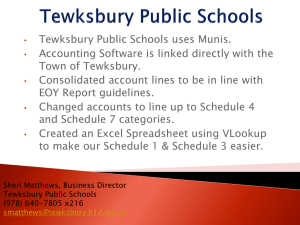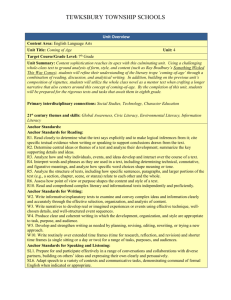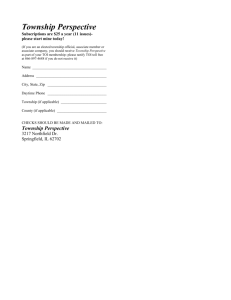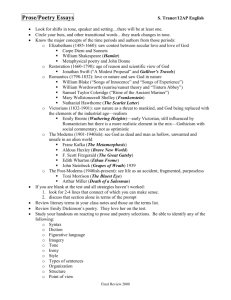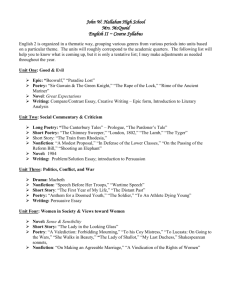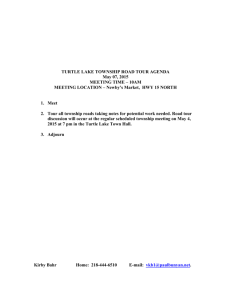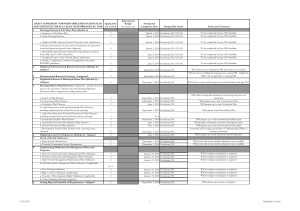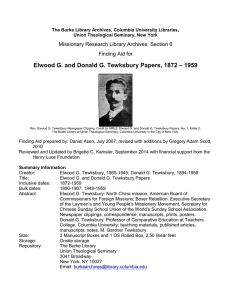Unit Overview - Tewksbury Township Schools
advertisement
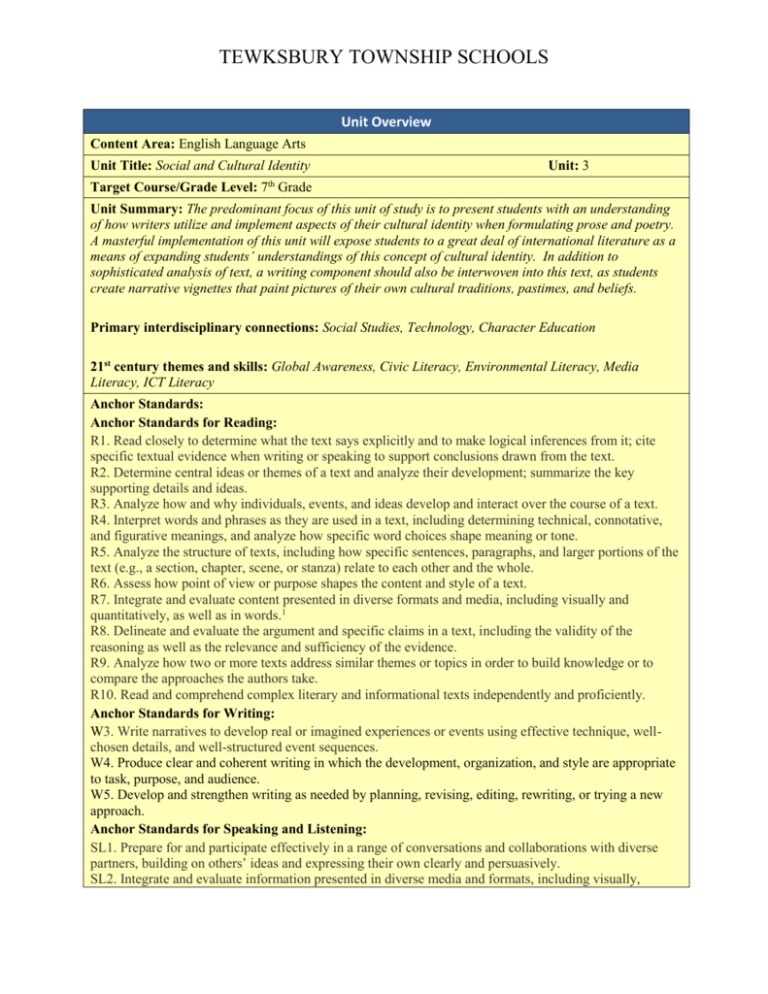
TEWKSBURY TOWNSHIP SCHOOLS Unit Overview Content Area: English Language Arts Unit Title: Social and Cultural Identity Unit: 3 Target Course/Grade Level: 7th Grade Unit Summary: The predominant focus of this unit of study is to present students with an understanding of how writers utilize and implement aspects of their cultural identity when formulating prose and poetry. A masterful implementation of this unit will expose students to a great deal of international literature as a means of expanding students’ understandings of this concept of cultural identity. In addition to sophisticated analysis of text, a writing component should also be interwoven into this text, as students create narrative vignettes that paint pictures of their own cultural traditions, pastimes, and beliefs. Primary interdisciplinary connections: Social Studies, Technology, Character Education 21st century themes and skills: Global Awareness, Civic Literacy, Environmental Literacy, Media Literacy, ICT Literacy Anchor Standards: Anchor Standards for Reading: R1. Read closely to determine what the text says explicitly and to make logical inferences from it; cite specific textual evidence when writing or speaking to support conclusions drawn from the text. R2. Determine central ideas or themes of a text and analyze their development; summarize the key supporting details and ideas. R3. Analyze how and why individuals, events, and ideas develop and interact over the course of a text. R4. Interpret words and phrases as they are used in a text, including determining technical, connotative, and figurative meanings, and analyze how specific word choices shape meaning or tone. R5. Analyze the structure of texts, including how specific sentences, paragraphs, and larger portions of the text (e.g., a section, chapter, scene, or stanza) relate to each other and the whole. R6. Assess how point of view or purpose shapes the content and style of a text. R7. Integrate and evaluate content presented in diverse formats and media, including visually and quantitatively, as well as in words.1 R8. Delineate and evaluate the argument and specific claims in a text, including the validity of the reasoning as well as the relevance and sufficiency of the evidence. R9. Analyze how two or more texts address similar themes or topics in order to build knowledge or to compare the approaches the authors take. R10. Read and comprehend complex literary and informational texts independently and proficiently. Anchor Standards for Writing: W3. Write narratives to develop real or imagined experiences or events using effective technique, wellchosen details, and well-structured event sequences. W4. Produce clear and coherent writing in which the development, organization, and style are appropriate to task, purpose, and audience. W5. Develop and strengthen writing as needed by planning, revising, editing, rewriting, or trying a new approach. Anchor Standards for Speaking and Listening: SL1. Prepare for and participate effectively in a range of conversations and collaborations with diverse partners, building on others’ ideas and expressing their own clearly and persuasively. SL2. Integrate and evaluate information presented in diverse media and formats, including visually, TEWKSBURY TOWNSHIP SCHOOLS quantitatively, and orally. SL3. Evaluate a speaker’s point of view, reasoning, and use of evidence and rhetoric. SL4. Present information, findings, and supporting evidence such that listeners can follow the line of reasoning and the organization, development, and style are appropriate to task, purpose, and audience SL5. Make strategic use of digital media and visual displays of data to express information and enhance understanding of presentations. SL6. Adapt speech to a variety of contexts and communicative tasks, demonstrating command of formal English when indicated or appropriate. Anchor Standards for Language: L1. Demonstrate command of the conventions of standard English grammar and usage when writing or speaking. L2. Demonstrate command of the conventions of standard English capitalization, punctuation, and spelling when writing. L3. Apply knowledge of language to understand how language functions in different contexts, to make effective choices for meaning or style, and to comprehend more fully when reading or listening. L5. Demonstrate understanding of word relationships and nuances in word meanings. Learning Targets/Activities Domain: Reading Informational, Writing, Speaking and Listening, Language Cluster: Key Ideas and Details, Craft and Structure, Integration of Knowledge and Ideas, Range of Reading and Level of Text Complexity, Text Types and Purposes, Production and Distribution of Writing, Comprehension and Collaboration, Presentation of Knowledge and Skills, Conventions of Standard English, Knowledge of Language, Vocabulary Acquisition and Use Standard # Standards RI.7.1 Cite several pieces of textual evidence to support analysis of what the text says explicitly as well as inferences drawn from the text. RI.7.2 Determine two or more central ideas in a text and analyze their development over the course of the text; provide an objective summary of the text. RI.7.3 Analyze the interactions between individuals, events, and ideas in a text (e.g., how ideas influence individuals or events, or how individuals influence ideas or events). Determine the meaning of words and phrases as they are used in a text, including figurative, connotative, and technical meanings; analyze the impact of a specific word choice on meaning and tone. RI.7.4 RI.7.5 Analyze the structure an author uses to organize a text, including how the major sections contribute to the whole and to the development of the ideas. RI.7.6 Determine an author’s point of view or purpose in a text and analyze how the author distinguishes his or her position from that of others. Compare and contrast a text to an audio, video, or multimedia version of the text, analyzing each medium’s portrayal of the subject (e.g., how the delivery of a speech affects the impact of the words). Trace and evaluate the argument and specific claims in a text, assessing whether the reasoning is sound and the evidence is relevant and sufficient to support the claims. RI.7.7 RI.7.8 RI.7.9 RI.7.10 Analyze how two or more authors writing about the same topic shape their presentations of key information by emphasizing different evidence or advancing different interpretations of facts. By the end of the year, read and comprehend literary nonfiction in the grades 6–8 text complexity band proficiently, with scaffolding as needed at the high end of the range. TEWKSBURY TOWNSHIP SCHOOLS W.7.3 Write narratives to develop real or imagined experiences or events using effective technique, relevant descriptive details, and well-structured event sequences. W.7.4 Produce clear and coherent writing in which the development, organization, and style are appropriate to task, purpose, and audience. W.7.5 With some guidance and support from peers and adults, develop and strengthen writing as needed by planning, revising, editing, rewriting, or trying a new approach, focusing on how well purpose and audience have been addressed. SL.7.1 Engage effectively in a range of collaborative discussions (one-on-one, in groups, and teacher-led) with diverse partners on grade 7 topics, texts, and issues, building on others’ ideas and expressing their own clearly. SL.7.2 Analyze the main ideas and supporting details presented in diverse media and formats (e.g., visually, quantitatively, orally) and explain how the ideas clarify a topic, text, or issue under study. SL.7.3 Delineate a speaker’s argument and specific claims, evaluating the soundness of the reasoning and the relevance and sufficiency of the evidence. SL.7.4 Present claims and findings, emphasizing salient points in a focused, coherent manner with pertinent descriptions, facts, details, and examples; use appropriate eye contact, adequate volume, and clear pronunciation. Include multimedia components and visual displays in presentations to clarify claims and findings and emphasize salient points. Adapt speech to a variety of contexts and tasks, demonstrating command of formal English when indicated or appropriate. Demonstrate command of the conventions of standard English grammar and usage when writing or speaking. -Explain the function of phrases and clauses in general and their function in specific sentences. -Choose among simple, compound, complex, and compound-complex sentences to signal differing relationships among ideas -Place phrases and clauses within a sentence, recognizing and correcting misplaced and dangling modifiers. Demonstrate command of the conventions of standard English capitalization, punctuation, and spelling when writing. SL.7.5 SL.7.6 L.7.1 L.7.2 L.7.3 Use knowledge of language and its conventions when writing, speaking, reading, or listening. L.7.5 Demonstrate understanding of figurative language, word relationships, and nuances in word meanings. Unit Essential Questions How does one’s culture contribute to individual identity? How does cultural ignorance cause stereotyping? Why do we tell/write stories? Unit Learning Targets Unit Enduring Understandings One’s identity is an amalgam of personal and cultural experiences. Stereotyping is the result of either intentional or unintentional cultural ignorance. Narratives are carefully structured depictions of diverse human experiences. TEWKSBURY TOWNSHIP SCHOOLS Students will ... • • • • • • • • utilize close, active reading strategies as presented through modeling to interact with an informational text. (RI.7.1, RI.7.2, RI.7.4, RI.7.6, RI.7.8, RI.7.10) recognize differences in structure and features in fiction and non-fiction text. (RI.7.5) describe and analyze the distinct elements of non-fiction text. (RI.7.5) identify the strategies an author uses to create bias. (RI.7.6, RI.7.8, SL.7.3) articulate their understanding of cultural stereotyping. (RI.7.4, RI.7.6, SL.7.1, SL.7.4) explain the possible impacts of stereotyping and cultural ignorance. (RI.7.3) compare and contrast a print and media version of the same story. (RI.7.9, RI.7.7, SL.7.2) utilize formal speaking techniques in order to articulate discoveries on their own cultural identity. (SL.7.4, SL.7.5, SL.7.6) implicitly articulate the purpose of a story by conveying theme via character, dialogue, and plot moments (W.7.3) frame a story around a consistent narrator’s point of view (W.7.3) develop lyrical prose through the use of figurative and sensory language (W.7.3, L.7.1, L.7.2, L.7.3, L.7.5) compose lyrical poetry that demonstrates understanding of the form, style, and function of the literary form (W.7.3) select vivid, accurate diction that reflects the writer’s growing vocabulary and understanding of connotation (W.7.3, L.7.1, L.7.2, L.7.3, L.7.5) use a variety of sentence types to create fluency in the prose (W.7.4, L.7.1, L.7.2) revise, edit and publish a finished narrative product (W.7.5, L.7.1, L.7.2) Learning Activities What is a vignette? Word study & vocabulary building Teacher-modeled writing evaluation Root words Poetry and short story analysis Nonfiction articles—reading, analysis, discussion Writing conferences Analyzing mood Peer editing SmartBoard games to introduce/review content Targeted figurative language responses Song connections & analyses Student-lead textually-based discussion Analyzing metaphors: synecdoche and Presentations on cultural identity metonymy Comma rules Symbolism & recurring imagery Analyzing compositional risks in prose: colon, Immersion into sensory language italicized words, ellipsis, etc Sharing of student writing Grammar games Evidence of Learning Formative Assessments Short written responses Exit cards Poetry and short story analysis Grammar mini-projects Individual vignette writing Reading quizzes Reading logs Discussion TEWKSBURY TOWNSHIP SCHOOLS Vocabulary activities (sentences, etc) Journal entries Summative Assessments End of novel test Vocabulary tests End of marking period grammar assessment Collection of cultural identity narrative vignettes Cultural identity presentation RESOURCES/TECHNOLOGY Teacher Instructional Resources: House on Mango Street by Sandra Cisneros* Three Cups of Tea by Greg Mortenson and David Oliver Relin Sadlier-Oxford Vocabulary Workshop Text New Jersey Registered Holistic Scoring Rubric Short Story Resources: “Two Kinds” by Amy Tan “The No-Guitar Blues” by Gary Soto Literary Nonfiction: “Superman and Me” by Sherman Alexie Firsthand immigrant accounts Poetry Resources: “I, Too, Sing America” by Langston Hughes “I Hear America Singing” by Walt Whitman “The Red Wheelbarrow” by William Carlos Williams Integration of Technology: WebQuest on Hispanic culture, SMARTBoard, document camera, internet Technology Resources: Click the links below to access additional resources used to design this unit: www.webenglishteacher.com www.sadlier-oxford.com owl.english.purdue.edu/owl Opportunities for Differentiation: - Model the writing process - Rubrics for projects/essays - Books on tape available for texts - Grouping - Technology (interactive SmartBoard) - “Chunking” reading selections - Question/discussion techniques - MI-inspired activities and lessons - Metacognitive strategies TEWKSBURY TOWNSHIP SCHOOLS Teacher Notes: While, at present, the selection of available resources at OTS features just one text (House on Mango Street) that aligns with the unit as it has been laid out on both countywide and schoolwide levels, it is not to say that teachers should feel limited to this text. Other “fictionalized memoirs” that touch upon similar themes of cultural identity would serve this purpose, as well. Hence, my inclusion of the popular nonfiction text Three Cups of Tea would be yet another; however, it should be noted that, as of this writing (2012-2013 school year), this book is not available whole class usage.
